

Table of contents
- damage picture
- Home remedies for lice
- Garlic broth
- Manure from nettles
- neem oil
- Curd and soft soap
- Tansy decoction
- baking soda
- Horsetail broth
- Brew from oregano
Aphids pose a threat to currants in domestic gardens. The pests suck the leaves and thereby damage the shoots. In this way, an infestation with the voracious insects prevents a good harvest. For successful control, shrubs should be regularly examined for the first signs. Natural home remedies are always to be preferred so as not to pollute either your own health or the environment.
damage picture
In the south of Germany, in Austria and in South Tyrol, currants are also called Ribisel. The native shrubs are mainly attacked by bladder lice. These pests hibernate directly on the branches of the shrubs, so they hatch together with the first sprouting leaves. Then the lice start their harmful sucking activity, which can lead to the loss of the entire harvest in the event of a severe infestation. In summer, the bladder aphid changes its host and moves to herbaceous plants. In the autumn months, the voracious insects return again to lay their eggs on the currants in winter.
- Bladder lice are green, size is only 2 mm
- Pests are often overlooked in the beginning
- Affected leaves show bulges
- Bloated blisters form on the underside of the leaves
- Lice are in the blisters
- Red currants have a reddish discoloration
- Yellowish-green coloring occurs in white and black varieties
- Suck the juice from leaves and young shoots
- As a result, the plant cannot develop enough nutrients
A notice:
Regularly check currants for infestation from spring to autumn, especially on the undersides of the leaves. Lice have often settled there, although no damage can be seen on the currant.
Home remedies for lice

The easiest way to control aphids is to collect and crush them by hand. However, this is only possible successfully if the infestation is still small and manageable. However, many people are disgusted by the pests and do not want to touch them. If the lice have already spread, the affected shoots can be cut off. These plant parts must be destroyed in the household waste to prevent re-infestation. In addition, hosing down the affected areas with a strong jet of water has proven helpful. However, the water jet should not hit the berries, as this can damage them. In addition to these mechanical measures, various home remedies against aphids have proven themselves. These funds are safe from the point of view of human health and the environment. Various plants and products from the household are used.
Garlic broth
Aphids on currants can be effectively driven away with garlic. The popular spice tuber contains essential oils and exudes an extremely pungent smell. The pests are repelled by this and stay away from the currant. In addition, the brew can be prepared quickly and easily, so that it can be combated in a timely manner. Since the odor is very strong, the brew should not be applied directly to the berries. Otherwise their fruity flavor will be unappetizingly distorted.
- Take 50 g fresh garlic
- Crush the cloves with a knife
- Then boil 1.5 liters of water
- Douse toes with it
- Then let it steep for about three hours
- Next, strain through a tea towel
- Pour the cooled brew into a bottle with a spray cap
- Spray the leaves of the affected plants with it
- Repeat every 7-10 days as a preventive measure
Manure from nettles

Our ancestors used manure made from nettles as a biologically harmless household remedy to combat aphids. Both fresh and dry nettle leaves are suitable for the production. Nettle extract has been shown to be effective for normal to moderate infestations. After preparation, the liquid manure should be well drained, but not yet start to ferment. In summer, the fermentation process starts quickly due to the warm temperatures, so the liquid manure should be placed in the refrigerator during this time of year. If the batch has nevertheless started to ferment, this mixture can be used as fertilizer for the currants. In this way, the currant's immune system is strengthened, so that an infestation with aphids is prevented.
- 200 grams of fresh nettle leaves are required
- Otherwise use 20 grams of dried leaves
- Roughly chop the nettles
- Soak in 1 liter of water for 2-3 days
- Then strain the mixture well and let it cool down
- Pour undiluted liquid manure into spray bottle
- Spray affected areas with the mixture
- Repeat every few days
Tip:
In some cases, the liquid manure develops an unpleasant smell. This process can be mitigated by adding some rock dust.
neem oil
Neem oil has its origins in Asia and has established itself there in Ayurveda. The potent oil can be purchased at health food stores and health food stores. Due to its strong mode of action and the intense smell, the oil should not be used undiluted. In the worst case, the currants could suffer damage. Since the agent is strong, the aphids stop their activity a few hours after the first application. If the neem oil is used repeatedly, the pests will flee completely.
- Mix 1 teaspoon of neem oil with 1 liter of water
- Pour mixture into spray bottle
- Oil settles, so shake well before each use
- Spray affected areas with it once a day
- Use several times a day if the infestation is very severe
- Then repeat preventively at intervals of 7-10 days
Curd and soft soap
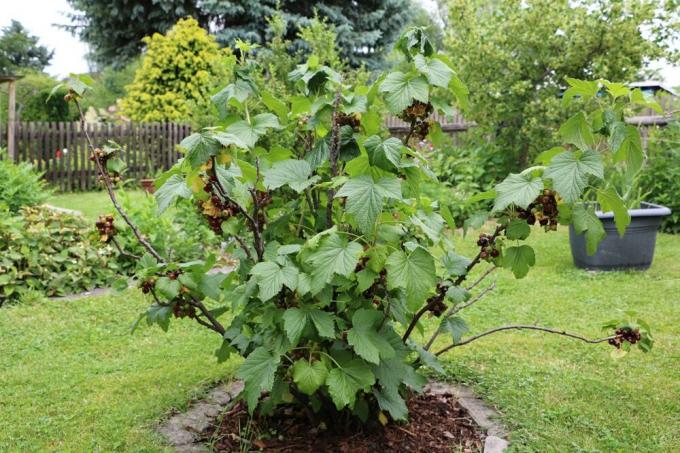
Curd and soft soaps have also established themselves in the fight against an infestation with aphids. There is no excess fat in these soaps, which is why there is no greasy layer on the sensitive currant berries after use. Since these natural soaps do not contain any artificial fragrances or dyes, no synthetic thickeners are used in production. Liquid soap products and scented soaps are also poor repellents as they contain strong fragrances and synthetic ingredients. If they were used, the flavor of the currants would deteriorate enormously.
- Organic soaps are ideal
- About 25-50 grams are required
- Roughly chop the bar of soap
- Then dissolve in 0.5-1 liter of lukewarm water
- Pour the cooled soapy water into the spray bottle
- Spray affected shrubs, omitting berries
- Soapy water should not drip onto the floor
- Wash berries well before eating
Tip:
If the infestation with aphids is rampant, the effect of the soapy water can be increased by adding alcohol.
Tansy decoction
The leaves of the tansy can also be used to make an efficient spray against lice on the currant. This strong brew is effective against all types of lice and can also be used for sensitive currants. Since this mixture contains a lot of potash, it sustainably strengthens the immune system of the shrubs. In this way, the plants become more resistant to infestation after application.
- 100 g fresh tansy leaves
- Roughly chop the fern
- Place in a saucepan with 0.5 liters of water and cover
- Let the leaves simmer on a low heat for about 1 hour
- Then cool and strain plant parts through cloth
- Dilute the brew with the same amount of water
- Then spray all affected parts of the plant
- Leave out the berries, otherwise the taste will be distorted
baking soda
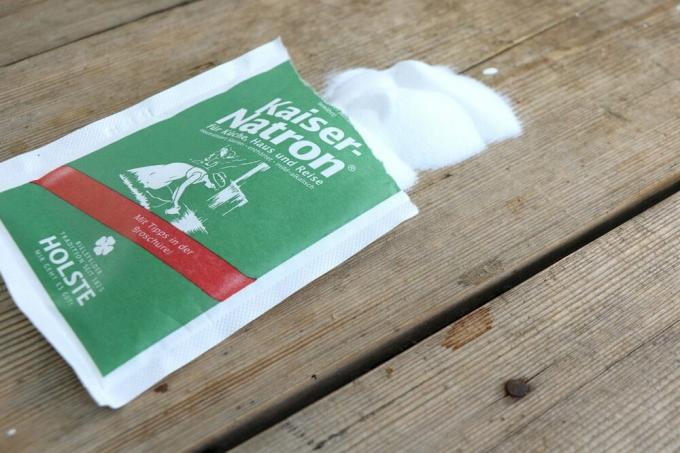
Baking soda is a household remedy with a wide range of uses and has also proven itself as an antidote to aphid infestations. Also known as sodium bicarbonate, the agent is not dangerous to humans or the environment. Depending on the severity of the infestation, the dosage can be adjusted and strengthened with additional ingredients.
- Add 1 teaspoon of baking soda to 1 liter of water
- Dissolve by shaking
- Supplement with neem oil if the infestation is very severe
- Alternatively enrich with alcohol
Horsetail broth
Field horsetail was already used by our ancestors to combat aphids. The native herb not only scares away the aphids, it also strengthens the currant's immune system as a preventive measure. In this way, the shrubs can better defend themselves against an infestation with lice. However, the horsetail broth is only effective for a light infestation. If the aphids have already multiplied a lot, stronger home remedies are required.
- Use 1 kilogram of fresh field horsetail
- As an alternative, use 200 grams of dry herbs
- Soak in 2 liters of cold water for 1 day
- Sprinkle the currants with the broth from time to time
- Then do it every week as a preventive measure
Brew from oregano
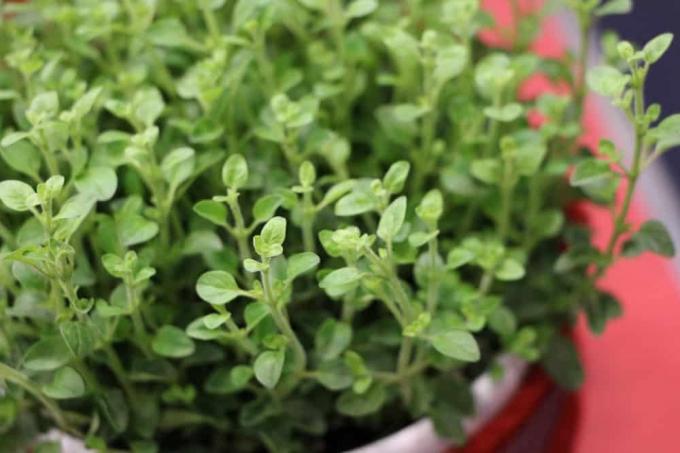
Oregano is a common kitchen herb and, in addition to being used in cooking, is also suitable as an antidote for lice. Due to the essential oils, the pests are permanently driven away. Since the herb is used by most households, the household remedy can be produced directly.
- Either use 100 grams of fresh oregano
- Otherwise, take 10 grams of dried herbs
- Boil 0.5 liters of water and pour it over the oregano
- Let the broth steep for 15-20 minutes
- Then strain all plant residues through a cloth
- Then dilute with water in a mixing ratio of 3:1
- Allow to cool thoroughly, then pour into a spray bottle
- Use every day against the pests
 Home editorial office
Home editorial office
Learn more about soft fruit
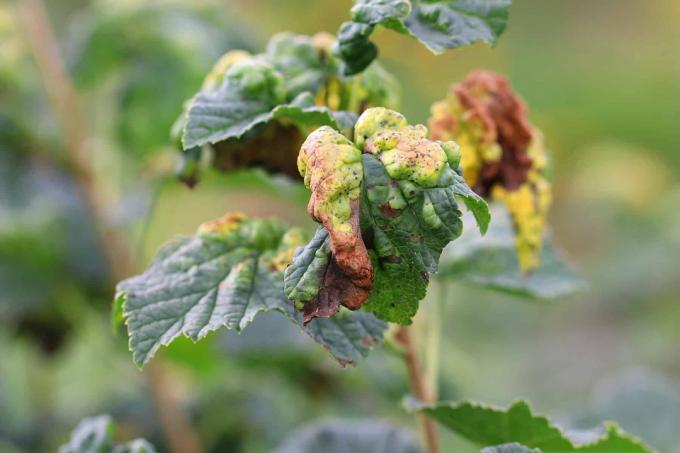
Leaf diseases on currants: leaf fall disease & Co
Diseases on the leaves are not uncommon in currants. They are triggered by fungi, viruses or various pests settle in. Many problems can be remedied with simple home remedies. Proper care also helps to prevent many diseases.

10 good neighbors of raspberries | mixed culture
Raspberries should grow healthily for several years and bring us a rich harvest every time. Choosing a good neighborhood helps to achieve this goal. But with whom does the berry plant like to share the bed and with whom not?

Honeyberry, Lonicera kamtschatica: 12 tips on location & care
In the local latitudes, the robust honeyberry can be cultivated and propagated well, as it does not make great demands on the site conditions and care measures. If you pay attention to certain factors when planting and cutting, you can already harvest sweet fruits in spring.

Cultivated blueberries: 4 important location criteria
The blueberry offers delicious fruits and is a visually appealing tree. However, the cultural form of the blueberry differs greatly from the demands on its location compared to its wild relatives. In the right location, cultivated blueberries can yield several kilos.
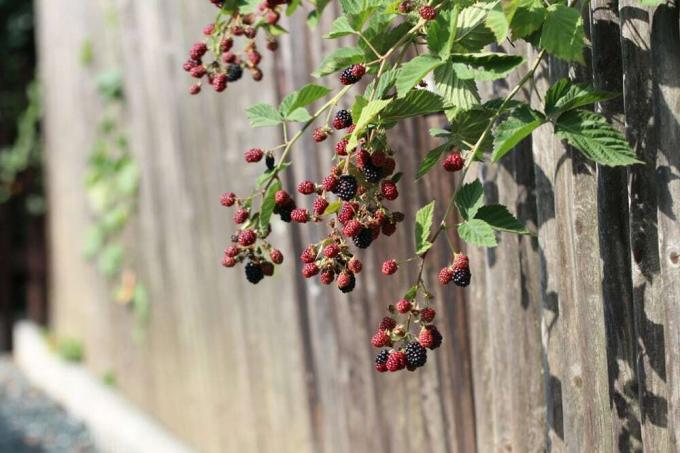
Blackberry location: 4 important criteria
Blackberries are a popular sweet fruit that is easy to care for. With a suitable location, plant health is guaranteed and the yield can be increased. The right location depends on the type of variety, because not every blackberry is insensitive to low temperatures.

Planting distance of strawberries, blackberries, raspberries & Co
Berries are the refreshing icing on the cake in the kitchen garden. With the right planting distance, you set the course for untroubled harvest pleasure in premium quality right from the planting stage. In this guide, you can read about the perfect planting distances in beds and balcony boxes for strawberries, blackberries, raspberries, etc.
